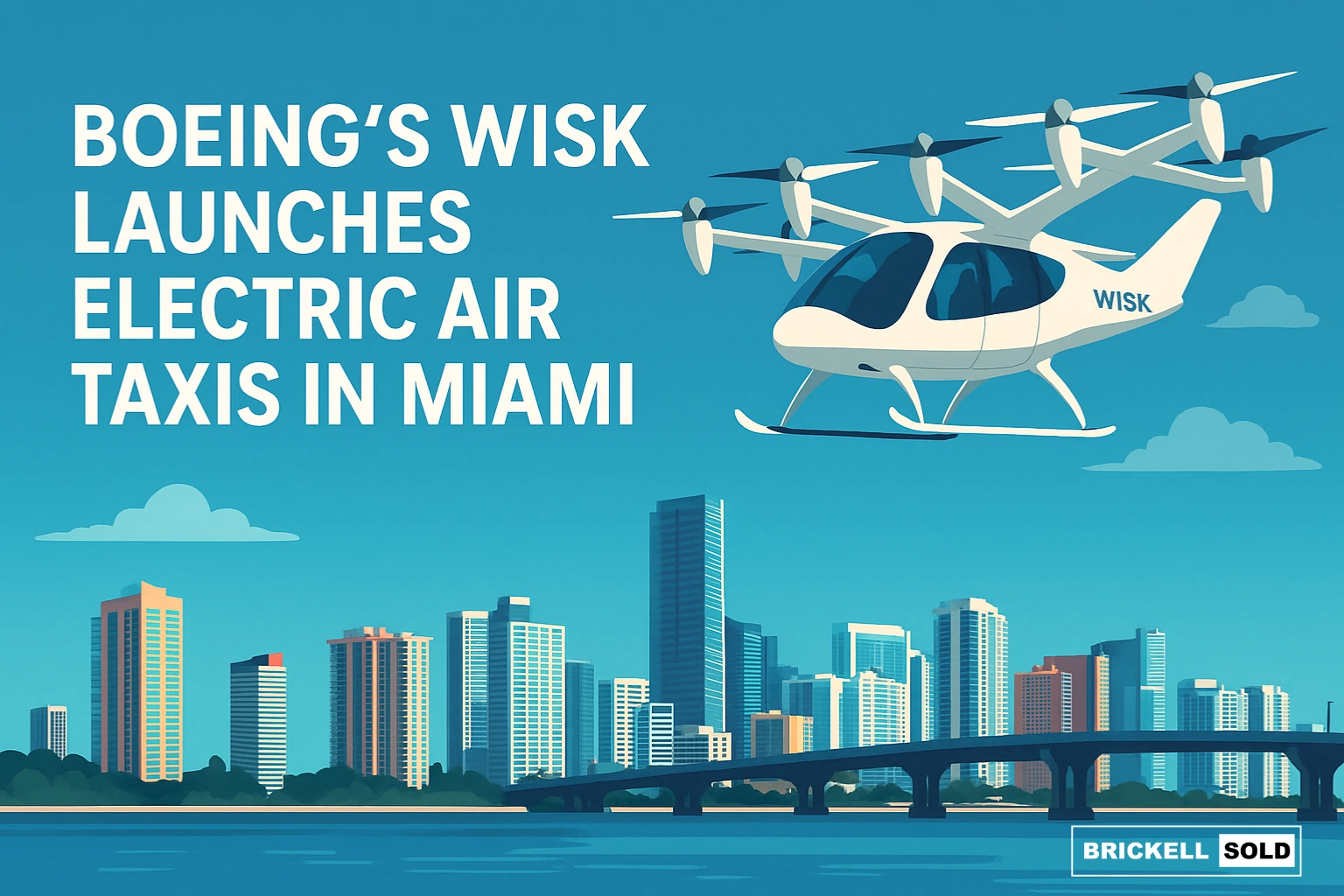In a bold leap toward transforming urban transportation, Boeing-owned Wisk Aero has announced Miami as the launch city for its fully autonomous, electric air taxi service. This pioneering decision marks a historic milestone in aviation, mobility, and smart city innovation. As Miami prepares to embrace skyborne commutes and zero-emission travel, the world watches closely, anticipating how this venture could reshape not only the city’s skyline but its entire transportation ecosystem.
In this blog, we’ll explore the significance of this launch, the technology behind Wisk’s eVTOL (electric vertical take-off and landing) aircraft, how Miami is gearing up for this futuristic mode of travel, and what it all means for commuters, businesses, and the environment.
A Skyward Vision: What Wisk Aero Plans for Miami
Wisk Aero’s choice of Miami isn’t just about scenic coastlines or bustling tourism. It’s a strategic decision based on urban challenges, government openness to innovation, and a willingness to invest in sustainable infrastructure. The company’s sixth-generation aircraft is a fully autonomous, electric air taxi designed to carry four passengers—offering a clean, quiet, and efficient way to navigate urban environments.
The plan? To integrate Wisk’s aircraft into Miami’s mobility network, enabling passengers to travel across the city in minutes rather than hours. The aircraft takes off vertically like a helicopter and transitions into forward flight like a plane, all without a human pilot onboard. A remote operations team monitors every flight to ensure safety and regulatory compliance.
Who Is Wisk Aero?
Wisk Aero emerged from a joint venture between Kitty Hawk Corporation (backed by Google co-founder Larry Page) and aerospace giant Boeing. The company has since become fully owned by Boeing and serves as the tech spearhead for Boeing’s Advanced Air Mobility (AAM) ambitions.
Wisk is known for developing autonomous flight systems, advanced battery-electric propulsion, and aircraft specifically designed for low-noise, safe operation over populated areas. With over 1,750 test flights completed and years of R&D under its belt, Wisk has positioned itself as a front-runner in the emerging eVTOL sector.
Miami: The Ideal Launchpad
Why did Wisk choose Miami? Several factors make the city an ideal starting point for an autonomous air taxi service:
Urban Congestion
Miami suffers from dense road traffic, particularly during peak tourism and holiday seasons. With its network of bridges, waterways, and urban bottlenecks, the city’s infrastructure presents daily commuting challenges.
Innovation-Friendly Governance
Local government has shown interest in mobility innovation, and partnerships with educational institutions and aviation authorities create an ideal ecosystem for launching new technology.
Tourism & Business Travel
With millions of visitors each year, Miami provides a diverse and dynamic customer base, including tourists, business travelers, and local commuters who are eager for fast and efficient alternatives.
Geographic Layout
The city’s combination of coastal zones, islands, and mainland hubs makes it a compelling environment for testing aerial mobility routes that are short in distance but long in travel time by car.
The Aircraft: Wisk’s Sixth-Generation eVTOL
At the heart of this urban air revolution is Wisk’s sixth-generation aircraft. Unlike conventional helicopters or piloted air taxis, Wisk’s vehicle is built to be fully autonomous from day one.
Key Features
-
Capacity: Four passengers
-
Propulsion: All-electric, vertical takeoff and landing
-
Wingspan: Approximately 50 feet
-
Noise Profile: 1,000 times quieter than a helicopter
-
Range: Estimated to cover 90-120 km per charge
-
Speed: Expected cruise speed of 100-120 mph
-
Pilot: No onboard pilot; aircraft is monitored remotely
This combination of automation, electric power, and safety systems represents a new paradigm in transportation—much like what Tesla did for cars, Wisk aims to do for the sky.
Infrastructure: Building a City for the Skies
For air taxis to work, cities need more than just aircraft. Miami will require the development of a full-scale vertiport network—specialized hubs for takeoff, landing, and charging.
Vertiports
These vertical airports could be placed on rooftops, transit centers, and purpose-built platforms across the city. Each vertiport will include landing pads, passenger lounges, maintenance areas, and rapid-charging stations.
Power Grid Integration
Since the aircraft are electric, powering them sustainably is crucial. Miami’s renewable energy initiatives will need to support charging infrastructure, possibly integrating solar panels and smart-grid technologies.
Airspace Coordination
Air traffic control for urban air mobility is still evolving. Wisk and aviation authorities will need to coordinate closely to develop safe flight paths, manage traffic flow, and avoid conflicts with conventional aircraft.
Regulation and Safety: Redefining Aviation Norms
Bringing autonomous air taxis to public use requires cooperation with local and federal aviation bodies. Safety remains the top concern.
Certification
The aircraft must meet rigorous standards for airworthiness, autonomy, and operational safety before it can carry passengers commercially. This involves multiple phases of testing and regulatory approvals.
Remote Monitoring
Each flight will be supervised from a central operations hub, where trained personnel can intervene or redirect the aircraft if necessary. While fully autonomous, Wisk’s system is designed with human-in-the-loop oversight.
Public Confidence
Safety demonstrations, community outreach, and transparency will be essential to gaining public trust. Wisk will likely conduct pilot programs, offer media demonstrations, and work with universities to share real-time data.
Environmental Benefits: Cleaner, Quieter, Greener
One of the biggest selling points of electric air taxis is sustainability.
Zero Emissions
Wisk’s aircraft produce no greenhouse gas emissions in flight. This aligns with Miami’s climate goals and helps reduce the city’s carbon footprint.
Noise Reduction
Traditional helicopters are notorious for noise pollution. Wisk’s aircraft use multiple small rotors and advanced noise-reduction technology, making them much quieter—critical for operations over residential areas.
Land Preservation
By taking travel to the skies, the city can relieve pressure on roads and highways, potentially reducing the need for future expansions or new infrastructure projects that would otherwise disturb ecosystems.
The Passenger Experience: Flying with Wisk
What will it feel like to ride in a Wisk air taxi? Imagine this:
-
You book your ride through an app, much like Uber or Lyft.
-
You arrive at the nearest vertiport—perhaps located atop a high-rise or at a shopping mall.
-
After check-in, you board the sleek, four-passenger aircraft.
-
The aircraft rises vertically, then transitions to forward flight, bypassing all the traffic below.
-
Within 10-15 minutes, you land at your destination’s vertiport, refreshed and on time.
It’s seamless, fast, and futuristic.
Economic Impact: Jobs, Investment, and Tourism
The arrival of Wisk’s air taxi service isn’t just a transportation breakthrough—it’s a major economic opportunity for Miami.
Job Creation
-
Vertiport construction
-
Aircraft maintenance
-
Remote operations monitoring
-
Customer service and logistics
Real Estate Development
Properties near vertiports may rise in value, prompting new commercial development and urban revitalization.
Boost to Tourism
Offering air taxi rides over Miami Beach or downtown could become a major draw for tourists seeking novel experiences.
Competitors and Collaboration: Miami as an Aerial Hub
Wisk isn’t the only player eyeing the skies above Miami. Other companies are also testing eVTOL technologies and building infrastructure, turning the city into a proving ground for aerial mobility.
While competition will heat up, the shared goal of safer, greener transportation may lead to partnerships in areas like vertiport construction, airspace regulation, and public education.
Challenges Ahead
While the future is promising, several challenges remain:
Regulatory Delays
Autonomous flight is still a new frontier for aviation regulators, and developing rules that ensure safety without stifling innovation will take time.
Infrastructure Cost
Building vertiports and charging stations across a city is expensive. Public-private partnerships may be needed to fund the rollout.
Public Skepticism
Convincing the public to board a pilotless aircraft will require a major shift in perception. Transparency, safety records, and education campaigns will be crucial.
Integration with Existing Transit
Air taxis must complement, not compete with, existing systems. Seamless transitions between air and ground travel will be key to long-term success.
Timeline: When Will We Fly?
Wisk aims to begin operations before the end of the decade. Here’s a rough roadmap:
-
2025-2026: Public demonstrations, continued test flights, FAA engagement, vertiport site selection.
-
2027-2028: Initial pilot programs with human backup operators.
-
2029-2030: Full commercial launch in Miami with autonomous flights.
Beyond Miami, Wisk plans to expand into other U.S. cities and international markets once operations prove successful.
A New Chapter for Urban Mobility
The selection of Miami as Wisk Aero’s launch city is a pivotal moment in transportation history. It signals the start of a future where flying across town becomes as normal as calling a rideshare. It also marks a shift in how cities think about mobility—no longer limited to streets, but expanding into the skies.
Wisk’s approach—combining autonomous flight, electric propulsion, and scalable design—offers a sustainable, safe, and revolutionary solution to the mobility crisis plaguing many major urban centers.
Conclusion: Miami Leads the Way
Miami’s leadership in embracing autonomous electric air taxis sets a powerful example for other cities around the world. By pioneering this technology, the city is not only solving traffic woes and embracing sustainability—it’s writing the blueprint for 21st-century transportation.
As the countdown to launch continues, residents and visitors alike can look forward to a future where traffic jams fade into history and commuting becomes an experience to enjoy, not endure.
So, next time you’re stuck on the highway in rush hour, just look up. The future of transportation is flying overhead—and it might be a Wisk aircraft coming to pick you up.

